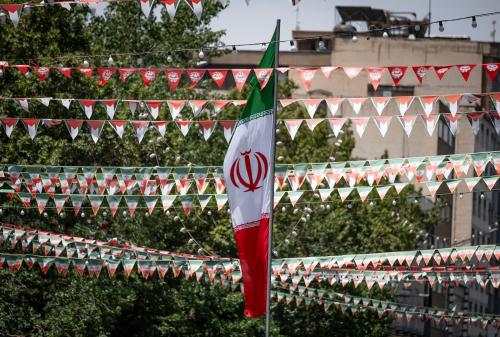The United States Air Force has long been the envy of the world’s militaries—sleek, high-tech and lethal to all who opposed it. Now, at a clandestine military base that serves as the headquarters for the Afghanistan air war, you stare at the rows and rows of decades-old planes and wonder how those things manage to make it into the sky.
A maintenance crew works on a rusting, Reagan-era B-1B bomber, its black, bird-like frame soaking in the desert sun. These days the plane has to spend 48.4 hours in the repair shop for every hour it’s in the air. Even older are the tankers that are supposed to keep those bombers (and every other airplane) flying. They were built during the Eisenhower and Kennedy administrations. Inside one cockpit, the navigator’s station is literally held together by duct tape. “It’s absolutely amazing it stays in the air still,” the pilot tells me.
For today’s wars, the Pentagon can get by with this fleet, plus some new drones and light surveillance aircraft. (The Taliban doesn’t have an air force.) But for tomorrow’s fights, those creaky planes could be a serious concern. Russia and China are working on advanced jets and next-generation anti-aircraft systems. Both countries are willing to sell their latest gear to the world’s most cancerous regimes.
The U.S. Air Force needs an upgrade. Bad. The problem is the funds to modernize are limited, and the war in Afghanistan has to be priority No. 1. So the trick is to get a new flying fleet on the cheap. It’ll be tough to do. But it’s not impossible.
Step one: Save those big bombers for the big wars. The B-1B was built to drop nukes on the Soviet Union. Over Afghanistan, it’s hovering overhead with a camera—acting like an oversized Predator spy drone. Each 12-hour mission for the bomber costs $720,000 in fuel, repairs and other costs, according to the Air Force. It’s a waste of a plane that could play a critical role in a larger conflict. “If the B-1 is not dropping its load of ordnance, we should withdraw it, and use unmanned systems instead,” says Michael Wynne, former secretary of the Air Force. “They’re much cheaper.”
Step two: Buy some new tankers, finally. The Pentagon has tried for a decade to find replacements for the ancient planes. Every year, the Air Force blows an extra $1.8 billion to maintain them. But politics and an arcane, broken system for purchasing new gear keep getting in the way. Enough already. There are two main bidders, Boeing and EADS. Pick one, or split the bid. But do something.
Step three: Streamline the stealth jet program. The idea behind the F-35 Joint Strike Fighter (JSF) project was to build lots and lots of really inexpensive jets for the Navy, Air Force, Marines and allied militaries. Eventually, those 2,457 planes were supposed to make up more than 90% of America’s combat aviation power. But the program’s budget is in danger of spiraling out of control. By some estimates, the total price could swell to as much as $388 billion, more than 50% higher than the original price tag. If that happens, it will jeopardize the JSF project and suck up virtually all of the remaining cash for new planes. The Air Force will be flying Cold War relics forever. That cannot happen.
Regimes world-wide are expected to buy up the new generation of Russian- and Chinese-made air defense systems. America needs a plane that can sneak past those systems, snoop on foes, and strike. “For any country with a decent air defense system, we’ll need F-35s. There’s no fighter alternative,” Mr. Wynne says.
A big chunk of the JSF’s cost overruns and technical complications are coming from the Marine version—the one that takes off and lands vertically, helicopter-style. It’s a neat trick but its battlefield utility is debatable. “The Marines have talked themselves into believing they really need this capability,” one senior defense official tells me. “But it’s one we’ve never counted on in any fight.” It may be better to scrap it.
Step four: Settle on a new bomber. America may never need to use it. But in the unlikely and deeply unfortunate event of a showdown with another major power, the military needs a way to penetrate thousands of miles into heavily-defended enemy territory—and take out hardened targets.
All sorts of concepts have been floated. Northrop Grumman is pushing a smaller-scale version of the stealthy “flying wing” B-2 bomber. Combine it with the autonomy of America’s unmanned aircraft and the new radars in the JSF, and the Air Force would have a plane that can avoid enemy eyes, collect information, fly vast distances with or without a pilot, and drop the heaviest bunker-busting weapons in the U.S. arsenal.
Step five: Invest in new weapons. Most of the debate in defense circles has been around new planes. But the missiles and bombs those planes deliver are often more important.
The Air Force is working on an experimental cruise missile called the X-51A. It flies six times the speed of sound and 10 times faster than the current weapons in its class. If the X-51A pans out, the Pentagon could have a weapon that can outrace enemy air defenses and take out targets hundreds of miles away in a matter of minutes. It’d be deadly for terrorists and big state militaries alike.
The Air Force recently conducted the first test of this experimental missile off the California coast. The futuristic weapon was shot off the tail of a B-52H—a bomber that first flew in 1961. And in that moment, the ancient plane was suddenly made new.
The Brookings Institution is committed to quality, independence, and impact.
We are supported by a diverse array of funders. In line with our values and policies, each Brookings publication represents the sole views of its author(s).



Commentary
Op-edThe Air Force Needs a Serious Upgrade
July 15, 2010